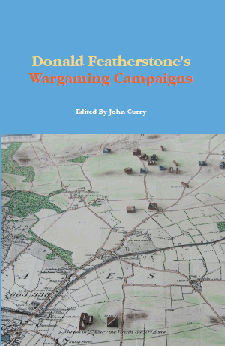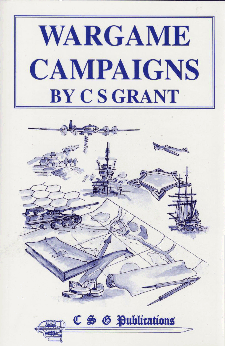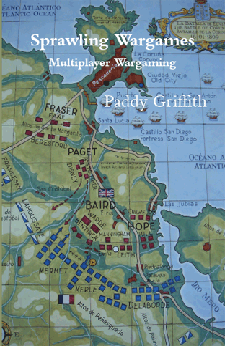This week's reading material has been Henry Hyde's new wargaming magnum opus, Wargaming Campaigns.
 |
It is a long book and it might best be thought of as a wargaming campaigns compendium, trying to give the most comprehensive coverage of the subject yet in print in English. Whatever else it does, it succeeds in this aim. If a reader has a mental checklist of campaigning then the chances are that this book will tick off each box. It gives reasonable answers to everything from "what is a wargames' campaign and why do it?" to "which are best social media tools out there to help me run a modern online campaign?".
This book refers to all the previous books on wargames campaigns that I am aware of, although naturally some are referred to more than others. In spirit, although Hyde is very much a 'Grant'-man, his book is much more like Don Featherstone's Wargaming Campaigns in spirit and execution than Grant's Wargame Campaigns. Is the use of the same name as for Featherstone's book a nod to this?
This is because Hyde's Wargaming Campaigns, like Featherstone's book, is much more wide-ranging with little snippets on each facet of campaigning and giving inspirational ideas rather than Grant's more focused effort, which concentrates on how to do a 'traditional' wargames campaign in some depth. That said, Hyde's work is much bigger than either so in a sense, has space to combine the two.
So, what does the book contain? It tries to describe wargame campaigns and explain why they are fun but also, importantly, why they can be hard work and why they fail. Next is an extensive treatment of what to consider in terms of putting together rules and scenarios for wargames campaigns. The numerous different possibilities of how to 'structure' campaigns are all described as are the different experiences which they lead to, for example from the simple structured and unstructured 'ladder' campaigns and 'battle leagues' and narrative campaigns to very detailed efforts with detailed geographic and economic models behind them. As might be expected from this author given his extensive interests in using imaginary armies and countries in his wargames, different methods of creating maps for wargaming are given a very extensive and useful treatment. It is pretty much authoritative, I would be surprised if anyone not a real specialist would need more than is provided here. Less expected but very usefully, the treatment of weather and climate is nearly as extensive with some simple but neat mechanisms for using it in campaigns and in the tactical battles it generates. I think the only thing that is missing is more ideas for actually physically representing weather, ground and light conditions on the gaming table itself, although a nifty game aid is proposed.
The author freely admits that in his own campaigning he has sometimes gone down some background rabbit holes which had more to do with fleshing out and wallowing in the detail of his own authorial creations than would be strictly necessary for wargames' background information. In some quite neat writing, he manages to both warn the unwary of the dangers of this and give helpful signposts to those who want to follow a similar path.
There are two main sets of campaign rules given by the author: a simple set focused on two sides in a relatively small area and another very comprehensive set aimed at 'everything' on land from the beginning of the Chariot Age to c.1900, although it could be used for later warfare as well. The rules look absolutely fine and I have used a version of them previously for a short campaign: it falls into the 'relatively detailed' category, but works fine. Where I think the author might have said more is on the translation from campaign map to wargames table and back again. I know from experience that this is a crucial part of successful campaigning and one of the main areas where a promising campaign can become unstuck.
As a wargames writer who doesn't want to neglect fantasy and science-fiction facets of both are discussed and the former has its own campaign with specific rules. This latter is a development of a scenario he had previously written and published in Miniature Wargames. It is also designed to showcase the benefits of smaller campaigns focusing on a relatively small number of combatants and the personalization that can bring. Even smaller 'squad-level' campaigns, or those focusing on a single ship or pilot, are mentioned but not developed as much. Solo campaigning is given quite comprehensive treatment though, so much so that it isn't put into a separate chapter but is referred to constantly throughout the book.
There is a very extensive section on including personality in campaigns, with some rules to support this. They are conceptually simple in that there are a number of personal characteristics which are generated by rolling d100 and then this is tested as a percentage or used as a bonus in certain circumstances. It seems to work okay although it does seem to generate quite 'extreme' characters: I think the system might work a little more smoothly if a player used 2d6 to generate the numbers and do the tests. I might also apply minima to some of the characteristics on the grounds that some personal characteristics might be disqualifying for certain roles.
Naval and air campaigns are covered, although the emphasis is largely on land actions. The naval chapter was rather good, containing enough information for a newcomer to have a go at setting up a reasonable campaign or at least including naval actions in a land-centred scenario. By contrast, the air warfare stuff I felt was one level less detailed and felt like a more high-level overview of possibilities and considerations. I think anyone interested would be better advised to find a copy of Mike Spick's Air Battles in Miniature, although to be honest I still think there has never yet been a really good campaign guide for WW2 and later combined operations.
By contrast, the writing on sieges - which are conceived of both as a process to be included in a campaign and as interesting campaigns in themselves - is outstanding and authoritative; in a way, Henry Hyde is competing with his own magazine articles for that position in the wargames pantheon since I know of nothing else as good, in particular if one is focused on C17-early C19 sieges. I suppose the section in Quarrie's Napoleon's Campaigns in Miniature is reasonably good too, thinking about it.
The author writes extensively about the development and current state of the media which can be used to support campaign play. This covers everything from the design of the materials (maps, game records, game aids) to the media used to communicate with players and the vices and virtues of each. This is reasonably extensive: the possibilities inherent in various media like Discord or Twitter seem to be quite inspiring for the author and I don't think there is anything better out there. It would be very useful for any readers considering taking on the projects in or similar too Paddy Griffith's megagames, and for gamers planning Play By E-Mail or other modern forms of multi-player campaigning.
The book also describes in some detail several campaigns, so the reader can get some idea of what this all looks like in practice. These include some of Henry Hyde's own campaigns, a Charles Grant campaign, a kriegspiel-esque game run by the Too Fat Lardies, part of the legendary 'Hyboria' campaign and a Ron Miles' extended siege. There is also a Steve Jones' 1809 Danube campaign scenario, re-printed from Miniature Wargames magazine I think, which looks absolutely superb: it has been on my own to-do list for a little while!
The tone here is quite infectious and the writing, although very good throughout the book, comes into its own here as the reader is slightly swept up in it. That said, although the author references some other types of campaign and provides links to them (including a couple of links to my own efforts amongst many others - many thanks to Henry Hyde for that), there is naturally much less emphasis on these. I don't mean this as criticism since an author will naturally default here to those he or she has most knowledge of and interest in compared to, say, a 'Tour of Duty' campaign set in Vietnam in 1966 featuring a single US Army platoon, or some such; but it is probably worth noting that compendious as this effort is, there are still many areas worth exploring. Using boardgames as a base engine for campaigns is mentioned, for example, and I have used them extensively myself; and another author might have laid more emphasis on these and the how-to of using them. I think all I am really getting at here is that Wargames Campaigns as a subject, because of the time they take to set up and play, are almost beyond any individual author having extensive experience of all of the various forms. But not the least value in this book comes from its really extensive links and references: the author has obviously taken great pains to link and signpost to a large number of resources and campaigns which demonstrate a huge variety of campaign ideas, scenarios and techniques that gamers use.
I thoroughly enjoyed this as a read. When I review wargaming books I will normally only do it after a play or two at the very least, but that would probably be too high of a standard for a book on campaigning, so I have treated it more as 'a book' than 'a game'. It forms a nice companion to his first book, The Wargaming Compendium.
I don't think it would replace the classics of the past for all readers, all of which focus on particular areas in perhaps more detail than this does. But as the ultimate collection of ideas and pointers and examples, this is the clear leader at the moment. The writing lets the author's enthusiasm and knowledge shine through whilst remaining clear. I read the electronic version so I can't comment on the infamous 'heft' of the book, but the design is modern and a model of current style, although the writing style seems self-consciously somewhat modeled on that of Charles Grant...
Heretical Campaigning - A Note:
The book has inspired me to think more about campaigns and how to do these better myself. It has also inspired me to think a little more about where the gaps are in terms of wargaming literature on campaigns. I mentioned earlier that I think one of the obvious ones is to do with WW2 Combined Arms campaigning. I don't think small-unit campaigns, especially by sea and by air, have yet been developed by the community as far as they might go. I think that there might be room for a more structured and detailed approach to the political super-structure of wargames campaigning thought of as a more usual game rather than a form of free(-ish) kriegspiel or role-playing game. It was great that this book spoke to both sides of the fuzzy, but definitely existing, line between the 'historical' and 'fantasy' camps of the hobby but I think the latter is much less well served in terms of writing about campaigning even though the subject is, if anything, even more suitable for it: after all, Waterloo has an attraction of its own even outside of the 100 Days.
But most of all - it is inspiring me to get something on the table as soon as may be!


/pic5300514.jpg)


Thank you so much for taking the time to review the book. Much obliged.
ReplyDeleteYou are very welcome - always a pleasure to read thoughtful books on wargaming and review them.
DeleteThanks for sharing your review, I found it very helpful.
ReplyDeleteThanks, glad it was useful to you.
DeleteThank you for writing the detailed review. Certainly looks likes a book to add to the Christmas list.
ReplyDeleteDefinitely worth a read for most wargamers and many will get a lot of value in having it on the shelf.
DeleteSuperb review! You provide a great summary of the contents and philosophy. Thank you.
ReplyDeleteThanks Jonathan, I appreciate that.
DeleteA mix of two styles can work. I'm using Sell Swords & Spell Slingers for the tabletop element and some training. The world the campaign is set in is The Forbidden Lands, an RPG game. It extends the campaign element and has tables for encounters, treasure etc.
ReplyDeleteMy first campaign years ago, a Achaemenid/ Classical Indian affair ended as most seem to.
That sounds interesting. I have done a little of that, using different rulesets for different scales of encounters, and I know some RPGs have had ways to tag on full battles. But the difficulties in moving from campaign world onto tabletop battlefield and back again will need even more attention, I imagine.
DeleteThank you for the review. Was there in your opinion any downsides to using the eBook version? Any need to print tables etc.out(which Kindle won't allow) and were there enough links to the different parts of the book (after all it is a rather long text)?
ReplyDeleteNow that is an interesting question. On balance, I think not: not because there aren't some problems (there are) but because I think wargaming books tend to be equally awkward to use. There are some issues with sizes of tables and so on, so for gaming use I would be using the Kindle App on PC rather than a Kindle itself. Sections of books can be photocopied of course, but equally sections of Kindle can be screen-shotted or snipped. I found the thing relatively easy to navigate but I am not sure if I would feel the same if I were using it to design a campaign world...I think I would find it handier than a book, but I am not going to guarantee that. So the bottom line for me is that I much prefer things like this in portable format even if it would be much handier if they were in pdf format sometimes. But other opinions on this issue are available!
DeleteI need to point out that this would have been a reviewer’s PDF copy supplied by the publisher which is not available to the public. It may not have have live links. The final ebook version will be Kindle and iBook variants, which should have live links.
ReplyDeleteNo, not at all (I don't get reviewers copies!). The links in the version are live. I bought the Kindle-readable e-book (i.e. in .mobi format) from the Pen & Sword website for £19.99, it is very much available to the public: https://www.pen-and-sword.co.uk/Wargaming-Campaigns-Kindle/p/21956
DeleteWell, that’s news to me. Hell, I’m just the author, so why would they bother to tell me! 😂
DeleteThanks for a very good and informative review JWH. I had pondered on buying this, but after reading yours and other reviews, the existing Featherstone, Bath et al books on campaigns I already have, plus the Warplan 5/5 maps, means I have everything I really need for my campaigns. Maybe one day this will be a Father's Day present though...
ReplyDeleteYou are very welcome Steve. I think it is certainly possible that a reader might already have sufficient coverage in their library to do the campaigns they want and the new stuff within Henry Hyde's book might go into the 'nice to have' rather than 'must have' box.
Delete